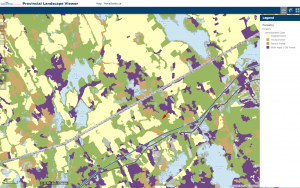In the context of the messages coming from COP25, the Lahey Recommendations are too little and their implementation by L&F far too tardy
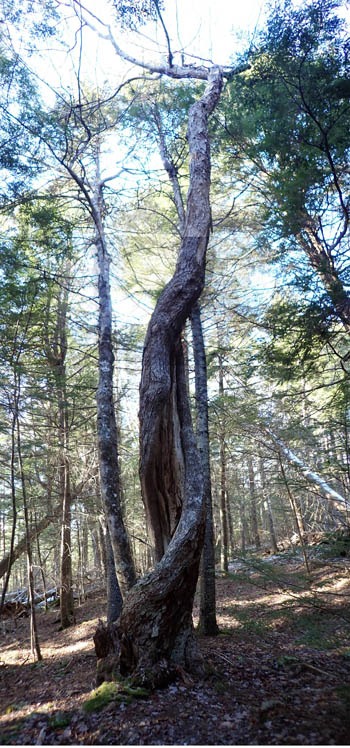
Who knows what forces caused the beautiful contortions of this now old red maple? It seems to express both the beauty and anguish of our natural world – including Homo sapiens – in 2019
Today (Sat Dec14, 2019):
The COP25 Climate negotiations in Madrid are set to continue today as countries are reported to be struggling to find common ground on issues related to finance and ambition.
The two week summit was supposed to conclude yesterday but many issues remain unresolved.
…The summit is meant to decide on rules for the implementation of the 2015 Paris Agreement on climate change.
The summit in Madrid arrives on the heels of climate-related disasters across the planet, including unprecedented cyclones, deadly droughts and record-setting heatwaves.
…The UN said this month that in order for the world to limit warming to 1.5C, emissions would need to drop over seven percent annually to 2030, requiring nothing less than a restructuring of the global economy.
In fact, they are currently rising year-on-year, and have grown four percent since the Paris deal was signed.
– COP25 climate negotiations set to continue in Madrid
On RTE (Ireland’s National Television and Radio Broadcaster) Dec 14, 2019
———–
I have found it challenging to write this blog over most of 2019; too much of the news around forests and forestry has been negative and even the best that we might achieve by fully implementing the Lahey recommendations appears far too inadequate to address the dual challenges of climate warming and biodiversity losses.
But a lot seems to have changed as we approach the end of 2019. Some how or another, concepts of radical change in how we act collectively and individually have become much more widely expressed and accepted by many, notably our youth.
 The scientific evidence for human-induced climate warming and loss of biodiversity is now pretty well incontrovertible. Where the science has ‘failed’, if it has, is in underestimating how fast drastic climate change would occur. That’s been the public awakening in 2019, spurred on in large part by the relentless fires in many parts pf the world, those a possible sign that we have passed one of the thresholds (tipping points) we were hoping to avoid.
The scientific evidence for human-induced climate warming and loss of biodiversity is now pretty well incontrovertible. Where the science has ‘failed’, if it has, is in underestimating how fast drastic climate change would occur. That’s been the public awakening in 2019, spurred on in large part by the relentless fires in many parts pf the world, those a possible sign that we have passed one of the thresholds (tipping points) we were hoping to avoid.
The major cause of biodiversity losses globally and locally to date is attributed to habitat loss and fragmentation rather than to climate warming although that’s beginning to occur. However there is a strong argument to be made that reversing biodiversity losses is itself critical to reducing climate warming, as well as being beneficial to us in many other ways, not to mention the benefits for our many co-inhabitants of Planet Earth.
A ‘Global deal for Nature‘ proposed by E Dinnerstin and 18 co-authors from the USA, the UK and China, published in Science Advances in the spring of 2019, appears to be the first comprehensive attempt* to combine a global landscape plan for conserving biodiversity with landscape aspects of the Paris Agreement in order to “avoid catastrophic climate change, conserve species, and secure essential ecosystem services.”
______
*E.O. Wilson, “the father of sociobiology” and “the father of biodiversity”, led the way conceptually with his book Half Earth: Our Planets Fight for Life (2016); view related website Half-Earth Project
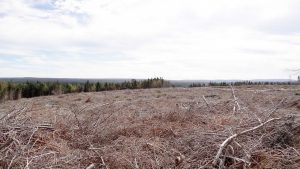
Clearcut in lands designated for the Raven Head Protected Area, 2011. We need to do better. Much better.
There is a lot in the paper and the plan surely will undergo a lot of refinement, however in outline the message is clear. We need to formally protect 30% of the landscape, and manage an additional 20% as “climate stabilization areas” by 2030. Those numbers may seem way out of bounds, but on the biodiversity side, the “land area needed to represent and protect most elements of biodiversity” was estimated as in the 50-60% range in research going back to the 1980s and 1990s* including for Nova Scotia:
_________
*e.g., as reviewed in Conservation targets: Do they help? by Soule and Sanjayan 1998; view also Naturalist E.O. Wilson on the Fight to Save Half the Planet for Wildlife
Biodiversity considerations in conservation system planning include three main criteria: representation, special elements, and focal species. A GIS-based approach utilizing simple models was used to assess existing biophysical data relative to these criteria for conservation system planning in Nova Scotia, Canada, with potential utility in applications elsewhere…Collectively, these biodiversity considerations indicate that ~60% of Nova Scotia, including 32% in core areas, should be managed for conservation objectives to maintain genes, species, and ecosystems over time. – Karen Beazley et al., 2005. Biodiversity considerations in conservation system planning: Map-based approach for Nova Scotia, Canada Ecological Applications, 15(6), pp. 2192–2208
By my rough calculations based on data from the 2016 State of the Forest Report, 30% Protected by 2030 would require circa 85% of our Crown lands to be protected if all of the increase came from Crown lands (in 2016, 31.3% or 580,383 ha of Crown lands qualified as Protected Areas); that doesn’t include the “additional 20% designated as climate stabilization area” – clearly in total, a large chunk of would have to come out of private lands.
| Note added Dec 24, 2019: In mandate letters for the newly elected federal government, pledges are made to work towards conservation of 25% of Canada’s land and oceans by 2025 and 30% by 2030. View Minister of Environment and Climate Change Mandate Letter (Dec 13, 2019) and Minister of Fisheries, Oceans and the Canadian Coast Guard Mandate Letter (Dec 13, 2019). View also the Make Room for Nature Campaign |
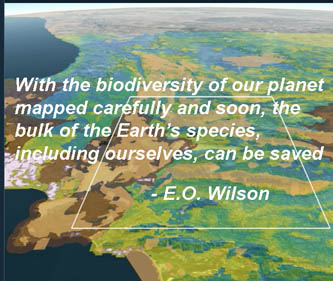
View the Half-Earth Project
Could, or would such a goal (30% land area protected + 20% as climate stabilization area) even be considered in NS? It would entail fundamental change in how we view and use and share our landscape within 10 years which would seem impossible – we are having so much angst just trying to implement the modest recommendations of the Lahey Report. Perhaps we could not.
But the price of inaction is becoming clearer every day with melting of the glaciers, sea level rise, record high temperatures, increasing frequency and intensity of storms and floods, erratic rainfall, never-ending fires and obvious signs of declining biodiversity; very few are now questioning the reality of climate warming and that it is human driven. So perhaps we would consider it.
The goals are quantitative and so we need to be quantitative in strategizing on how we get there, and to assess how we are doing. As a start on developing a Deal for Nature for NS, we need to see the numbers and we need to see the maps. Platitudes won’t do it.
We need the maps because how we select the land is important, as detailed in the paper, notably in relation to Landscape Level Planing for Biodiversity Conservation which has so far proved beyond the capabilities of Nova Scotia Lands and Forestry. It’s actually a far bigger job than a single or even a few government employees should attempt to undertake. It could be led by Government in the broadest sense (politicians and bureaucrats & non-political) with the technical component involving experts from Government, Academia and Private Enterprise. For public buy-in, the process and the results would have to be be 100% transparent and readily and universally available. It would be a dynamic database, continuously updated and revised. We would need to tap our collective social skills to engage all of us and to come up with a plan for moving ahead that has widespread support.
Achieving the 2030 targets might not require as much sacrifice as we might think at first blush, for example a lot of the land involved would probably qualify for inclusion in its present state with little or no change otherwise; it’s the options for future use that would be restricted. But without credible maps and numbers, we don’t know our options.
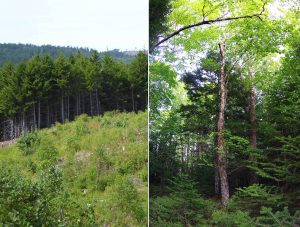
Two approaches to forest management in Nova Scotia: LEFT: even aged management/short rotations. RIGHT: Selective harvesting only, high standing volume maintained. The latter but not the former would be eligible for carbon offset credits; can we make it the more attractive option for private woodlot owners in NS?
Some forestry would probably still be possible, but along the lines of Dale Prest’s Climate Forests, not the mishmash of current practices or even those that would exist if we fully implemented the Lahey recommendations – I think we are already past that option if we want to do our part as global citizens to mitigate climate change, and as Nova Scotians to conserve our own biodiversity.
Regardless, even under the Lahey model, forestry options should be evaluated for their impacts on GHGs through comprehensive modelling and cradle-to-grave Life Cycle Assessments of the forestry operations and the downstream product chains. It was a major failing of the Lahey Report not to recommend such accounting.
We also need numbers generated by high level models and strict accounting to help us individually and collectively on the Reduce-GHG-Emissions side. On that score we need leadership from Ottawa. Essentially we need to know the GHG emissions associated with pretty well everything we purchase and do and to make choices and set taxes to bias the choices accordingly.
We will change, perhaps, because the simple numbers and experience of drastic events convince us that it is in our own self-interest to do so. But that also invites cheating – essentially, the reasoning goes, if everyone else is doing it, I (or my larger group) don’t need to and it is in my self interest to cheat.

Youth outnumbered ‘adults’ amongst the participants in the Law Amendments Committee Public Hearing on the SUSTAINABLE DEVELOPMENT GOALS ACT (Oct 28, 2019)
That’s where ‘ethics’ can help. In that regard, Liberal Government’s handling of the SUSTAINABLE DEVELOPMENT GOALS ACT has been very disappointing, especially to our youth.
The Act is not somethings just to tick off, it is a statement of and commitment to a collective environmental ethic.
It’s a good reminder to go back to the act as passed unanimously in 2007. A few components:
This Act is based on the following principles:
…(c) the environment and the economy of the Province are a shared responsibility of all levels of government, the private sector and all people of the Province;
(d) the environment and economy must be managed for the benefit of present and future generations;
…4 (1) The long-term environmental and economic objective of the Province is to fully integrate environmental sustainability and economic prosperity and to this end to
(a) demonstrate international leadership by having one of the cleanest and most sustainable environments in the world by the year 2020;…
On a more limited scale, Dale Smith, taking a cue from Bob Bancroft, has argued that we are in need of a “land ethic”. That, says Smith, “is essentially a moral code that recognizes humans must live in harmony with the land base that supports us, and is at the heart of science-based concepts of biodiversity protection, sustainable use and responsible stewardship”.
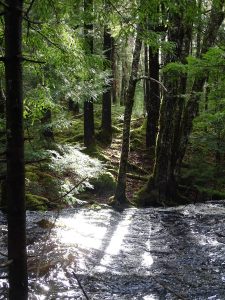 Smith says the place to start is with our pubic lands and notes that while the Lahey Report and the government’s response offers “a glimmer of hope”, it doesn’t go far enough. Says Smith,
Smith says the place to start is with our pubic lands and notes that while the Lahey Report and the government’s response offers “a glimmer of hope”, it doesn’t go far enough. Says Smith,
The ecological approach to forestry recommended by Lahey must be reframed and expanded to encompass more fully the ‘ecological stewardship of all public lands. If not, Lahey’s Ecological Forestry, however well-intended will entrench the longstanding bias of viewing Crown land through a forestry lens.
He goes on to suggest:
“The one remaining hope for real progress is through the review and updating of the Crown Land Act as recommended by Lahey and promised by government. The expressed intent is to remove this legislation’s current bias towards timber production and give equal weight to the full range of values and uses that are relevant – biodiversity protection, provision of ecosystem services, outdoor recreation and nature tourism, fishing and hunting, and commercial resource use use including forestry.
Reform of our Crown land legislation can and must establish the land ethic needed to lead a paradigm shift from industrial forestry exploitation to responsible ecological stewardship
I agree but it’s clear also that, given the time-frame in which we really have to make fundamental change, we need to apply such an ethic to all of our lands, private and public. What we do on private land has as much to do with the the state of our Global Commons (our air and water and biodiversity) as what we do on public land. The public license for treating private land as the exclusive domain of the specific owners is rapidly is running out, like that for NP’s pollution of our air and of the waters of the Northumberland Strait.
I recognize that there are many forest land-owners now who are contributing to ‘the solution’ by practicing truly sustainable forest management – in fact the best examples are to be found on private, not Crown lands. (Crown and private lands share the worst practices.) Others are contributing by simply maintaining natural forests as natural forests but are penalized tax-wise for “doing nothing” – that clearly has to change!
I’ve got grandchildren. I have come from five generations of guides, hunting and guiding in East Camp and we rely on the forest and we always will in one shape or form and if nothing else, then to create the oxygen we breathe and to sequester the carbon that we are polluting the earth with and if we knock it all down, cut it all down, it’s not going to be there – Ken Gray
I respect that the Mi’kmaq peoples have always had a much more communal perspective on land ownership and have “other ways of seeing”. Their concept of “two eyed seeing” is, in a sense, what we are doing when we (the settlers and those following) recognize the appropriateness of – and now the urgent need for – viewing the world through both an ethical lens and a scientific lens.
As Shalan Joudry says, we must begin a conversation of reconciliation between peoples and between peoples and the land.
Each generation must make their own journey through a thick terrain.
How ever we get lost along the way, let us rejoice in the healing steps that follow.
I hope we all continue to gather at the edge of the woods where the generations before us and after us re-merge.
– From the Prologue to Generations Re-Merging by Shalan Joudry

Annapolis Co. proposed to manage this forest as a “Climate Forest”
There are some encouraging signs of fundamental change in how we relate to our natural world as a society. Annapolis Co.’s proposal to manage some their Crown land forests and to manage them as “climate forests” is one, unfortunately, too progressive for ‘approval’ by the powers that be right now. Another is the Halifax Green Network Plan which incorporates some of the concepts and accounting of the Global Deal for Nature.
Most encouraging to me are the ethically driven actions of many individuals and groups without the intercession of government or a need for detailed accounting of the costs and benefits. A recent example:
Fixing the forests – Turning clear-cuts into homesteads a win-win on Hampton Mountain
Lawrence Powell in The News (New Glascow)., Dec 5, 2019. “The new [clearcut] property could become that. They’ve already identified some good spots to build homesteads there. People are already interested — the new homesteaders who understand the dividends they receive have nothing to do with stock portfolios but with what nature can offer sustainably if you put in the hard work on her behalf….“A place where they feel like they can do something. That’s one of the biggest issues. Everyone knows what kind of trouble we’re in but everybody feels powerless to do something about it,” he said. “This is the ultimate win-win. The government wins. They get to meet their targets. The people get a purpose that they feel good about. It fosters a community spirit. The environment is improving. And we’re also building a forest inventory that hopefully in the future can be more sustainably managed by our kids and grandkids. It’s a long-term strategy and I don’t see how anybody can lose.””
I don’t either.

A wildlife-supporting cavity tree still standing at the Corbett-Dalhousie Lakes forest, June 15, 2019
A few related links
IPCC SPECIAL REPORT: Climate Change and Land
An IPCC Special Report on climate change, desertification, land degradation, sustainable land management, food security, and greenhouse gas fluxes in terrestrial ecosystems
Cut global emissions by 7.6 percent every year for next decade to meet 1.5°C Paris target – UN report
UNEP Nov 26, 2019, Press Release
Choices made now are critical for the future of our ocean and cryosphere
IPCC PRESS RELEASE 25 September 2019
The Arctic may have crossed key threshold, emitting billions of tons of carbon into the air, in a long-dreaded climate feedback
By Andrew Freedman December 10, 2019 on The Washington Post ” The Arctic is undergoing a profound, rapid and unmitigated shift into a new climate state, one that is greener, features far less ice and emits greenhouse gas emissions from melting permafrost, according to a major new federal assessment of the region released Tuesday.”
As Climate Change Worsens, A Cascade of Tipping Points Looms
By Fred Pearce, dec 5, 2019 on YaleEnvironment 360

The barred owl requires large trees for nesting. The 2nd Breeding Bird Atlas commented that “there appearred to be some decrease in western NS, potentially because forest harvesting has recently increased in that region.
Could we set aside half the Earth for nature?
Jeremy Hance in The Guardian Jun 15, 2016. “Renowned biologist E O Wilson wants to set aside half of the planet as protected areas for nature. But is this possible? And, if so, how would it work?” Also view the Half-Earth Project (website)
‘We are losing the web of life’: why the global nature crisis is as dangerous as climate change
Emma Howard & Georgie Johnson on unearhed.greenpeace.org. May 6, 2019. Good overview
Fires in the Amazonian and Boreal Forests: more reason to increase carbon storage in our Acadian forest by “proforestation” 26Aug2019
Post on NSFN Aug 26, 2019
Nova Scotia municipalities lead the way in addressing climate and biodiversity crises, L&F Please follow! 26Sep2019
Post on NSFN Sep 26, 2019
Time for Nova Scotia Government to come clean on forest bioenergy feedstocks 19Mar2019
Post on NSFN Mr 19, 2019
Biodiverse Southwest Nova Scotia at Risk
Post on NSFN Oct29, 2018

